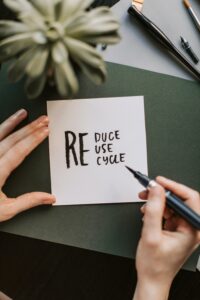Sustainability is becoming increasingly important. Not only for the environment but also for business! Businesses have the power to make a difference when it comes to climate change, and consumers know it. This leads most consumers to factor in sustainability when vetting their purchases. Recent studies found like two-thirds of them do and almost 60% of Americans consider themselves conscious consumers.
What does Sustainability really mean?
The UCLA Sustainability Committee defines Sustainability as “the integration of environmental health, social equity and economic vitality in order to create thriving, healthy, resilient communities for this generation and generations to come.”
Sustainable practices take into consideration environmental, social and economic wellbeing and presume that resources are finite and should therefore be used wisely so that future generations are not deprived of the same resources we had. In short, sustainability means meeting your own needs without compromising the needs of your children and grandchildren.
That makes sense, right? But it’s much easier said than done – especially in the retail industry. If you think about it almost everything we do leaves behind a carbon footprint. On our Webinar, Talking Sustainability, we asked our guest speaker and owner of a sustainability driven apparel store in Brooklyn, Kelly Wang, one thing she wished everyone knew about sustainability. This was her answer:
“The fact that it doesn’t exist, really. That would probably be my biggest thing. I understand why we had to put a label on it – to be able to talk about it and the impacts – but in truth, at least in my opinion, there really is no “sustainability”. Which means zero impact. There is only low impact.”
– Kelly Wang, Rue Saint Paul
Tips to run a low-impact business
First, set some sustainability goals. Do some research on what your customers want and what your competitors are doing, look at your business with a magnifying glass and see where you can cut down on waste and set some achievable objectives. to reduce, improve your product lifecycle, and try out a circular model.
Check in on your supply chain
For businesses, rather than meaning reducing what they buy, ‘reduce’ indicates cutting down on unnecessary waste and resources they use during the process of getting an item to their consumer. Aka, making their supply chain more sustainable. This can be done in four steps:
Map it out
The first, and arguably most important, step in cleaning up your supply chain is getting a comprehensive understanding of its sustainability impacts. Determine the risks and waste-drivers by getting a visual representation of your chain. In seeing where they are, you can evaluate where changes can be made.
Pro tip: Technology is a very convenient way to map out your supply chain. Good analytics and reporting allow you to continually improve your process. Every change that reduces waste can enhance quality and bring you closer to your sustainability goals.
Source Sustainable Products
Start with the suppliers. Identify their environmental and social challenges and prioritize reducing those waste drivers. Evaluating how your suppliers are producing and extracting materials to ensure they fall in line with your sustainability goals is vital. What are their sustainability standards? Are they willing to improve them? If they are not inclined to change their ways, find someone who will.
Pro tip: If you are looking to change supplier, it may also be worth looking for someone who handles locally sourced materials, as often they will be produced following the same (national) health & environmental guidelines you already know, and you can save costs and emissions related to travel and transportation.
Communicate your values & introduce transparency
Communicate corporate values and culture to your suppliers and customers. By establishing a communication channel with your suppliers, you are divulging a code of conduct that will ideally involve them in your sustainability efforts and by communicating your efforts, goals and achievements with your customers, you can instill a sense of trust and ethics – which will reflect positively on your brand’s identity.
Pro tip: Internet of things (IoT) devices can help monitor working conditions and environmental factors within your supply chain.
Collaborate with other companies
No matter how hard you try, you can’t solve all your supply chain issues alone. There is strength in numbers and, while it may seem counterintuitive, working with your competitors to develop sustainable practices in supply chains will benefit you all. This will allow you to set common standards which all your suppliers will be held accountable to and will help you make an impact on the future of the industry as a whole.
Pro tip: Take consumer demand into consideration when planning your supply chain production requirements, this can help limit the possibility of waste from products that remain unsold.
Think in circles
A circular economy is based on the principle of wasting as little as possible. Where every resource that it takes to make one product can either be recycled to make another or repurposed to extend its life cycle. A circular business model can come in many shapes and sizes and it’s great to see so many businesses getting creative about how they can reduce their waste and become more circular. Here are some ways in which they do it:
Start with circular supplies
Implementing a circular supply strategy can mean many different things (recycling, repurposing, reusing, reconditioning, etc.), but the bottom line is that it starts with the material you use to create your product. Many businesses have even taken this a step further and created products with industry bi-products – such as sneakers made out of plastic bottles (like those made by All Birds) or business cards made out of cotton t-shirt scraps (like those Moo produce).
Extend product value
By making high-quality, long-lasting products you can ensure durability and the possibility for repairs to be made to give that product another round! Cheap may have been great 10 years ago, when consumerism was rampant and the average consumer bought cheap to buy more, but today’s consumers are much more interested in quality over quantity – buying less and spending smarter. This gives you the opportunity to make the best product possible even if it costs a little more.
The market has responded to this shift in consumer mindset by giving room to alternative ownership options – where brands like Rent the Runway, ZipCar and Rue Saint Paul sell pre-owned goods to give them a second, third or fourth life!
Look into circular design
“The thing that most excites me is starting at the very beginning of the sustainability process – the design. Circular design. What that means is, when you design something, […] think about when that person is done with that sweater. We don’t think about if it’s going to go to a landfill, how it’s going to go back to the earth, what happens at the end of the lifecycle of the garment. So I think a lot of designers now have that in mind, but it’s incredibly difficult and a lot of that is going to depend on technology; coming up with new fabrics, with new materials that are biodegradable or that can be recycled at the end of their lifetimes.”
– Kelly Wang, Rue Saint Paul
While no impact is extremely difficult, we can all agree that sustainability is finding a form of harmony. One in which we can coexist with nature and not impact future generations. This begins at the very foundation of the supply chain – reinventing the wheel of how things are produced. This is already happening and has led to incredibly creative solutions to create products using natural fibers that can be put back into the earth.
Technology has been instrumental in doing so and can enable us to innovate even further. Businesses have the opportunity to push past conventional thinking, and use technology and creativity to drive the design and availability of greener, cleaner products.
Join the Fight Against Climate Change
and much more. Get retail tips, trends and news! Be part of the e.pop merchant community!

Francesca Gobbetti
Community Manager at e.pop. Social and environmental awareness is what keeps Francesca up researching and writing the occasional blog after hours.


